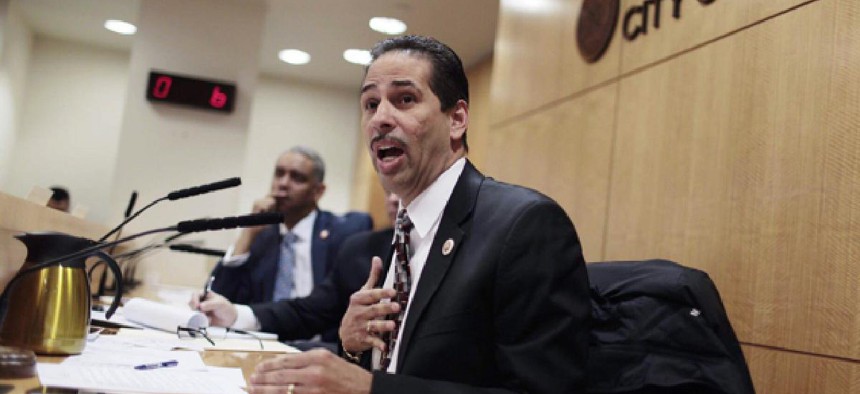ACS promises progress in Close to Home

Photo: William Alatriste/City Council
The Administration for Children’s Services went on the defensive at a committee hearing yesterday, announcing that it has hired more investigators, stepped up its oversight of nonprofits managing the Close to Home juvenile justice program and raised standards for monitoring video surveillance.
The changes are in response to a city Department of Investigation probe that uncovered a cascade of failures at a Brooklyn facility that allowed three 16-year-olds to escape in June 2015 and rape a woman they met at an Internet café.
The Close to Home program, which began in 2012, places young offenders in residential facilities closer to their communities and allows them to enroll in rehabilitation programs, with the goal of reducing recidivism. Eight nonprofits – which include Children’s Village, Sheltering Arms, Leake & Watts Services and SCO Family of Services – contract with ACS to place children across 25 sites in or near the city.
During the June 27 hearing before the City Council’s Juvenile Justice Committee, committee chairman Fernando Cabrera asked ACS officials if an incident similar to the one in 2015 could occur again. “Would you be shocked if we were to have a part two of Boys Town?” he said.
“No,” said ACS Deputy Commissioner for Youth and Family Justice Felipe Franco, adding that transparency was important. “We’re doing something that everyone is looking at, and again, not just in New York City. We need to get it right.”
ACS officials said that the total number of AWOL children across all non-secure sites dropped by 69 percent since 2013 to 233 last year. Officials also conceded there were nine unaccounted juveniles among the 159 currently in the program. Franco said the AWOL incidents typically happen when a child gets a pass to visit his or her home, go to school or visit other places in the community.
“For lay folks, you would think of an AWOL as a kid running away from the home in the middle of the night,” Franco said. “Those actually hardly ever happen...Most of those circumstances are actually young people who are out on their home visit and they kind of take longer than they should get to get back.”
The average time a child was unaccounted for was less than two weeks, but John Dixon, Associate Commissioner for Close to Home, noted the total included some who were missing for much longer. “We have one that was AWOL from almost the beginning of the program, we have others that are AWOL an excess of 100 days,” he said, adding the number of kids who left recently was “four or five.”
Some Council members maintained that the number was a serious matter.
Following the DOI investigation, three staffers at the Brooklyn Boys Town facility were arrested and charged with falsifying log book entries. Though they claimed to have conducted bed checks of youths in the program, some were caught on surveillance cameras lying down and leaving the facility while on duty. That facility has since been closed by ACS.
“You’re asking us to be upfront with our constituents, but when people hear that 6 percent of the young people in this program are missing, that is an awful lot of people,” said Councilman Barry Grodenchik. “If we had a school … where 6 percent of the children were missing, that school would be closed or the principal would be fired.”
“What happened at Boys Town was a complete failure of the basic requirements of Close to Home,” Franco said. “Close to Home was premised on one thing: that actually having a significant amount of staff would make these facilities not just safe, and the communities safer, but actually would make them rich in terms of outcomes for young people.”
ACS agreed with all of the recommendations DOI made in its April report and is now working with an expert to strengthen the system, adding more personnel, implementing “performance based standards” and training agency employees to monitor providers.
Site visits – half of which are unannounced overnight visits – will now happen eight times per year instead of a minimum of four. A $4 million increase in the Close to Home budget is being used to fill 35 new positions in the policy, planning and measurement, IT and investigations departments.
ACS also now requires providers to conduct six daily headcounts, two of them overnight, a dramatic increase from what was previously mandated. And instead of using letter grades to assess nonprofit providers’ performance, it will use nationally accepted benchmarks.
Councilman Rory Lancman questioned the ACS officials on plans to standardize video monitoring requirements across the 25 facilities. “Video surveillance seems to be really important to your response to what the DOI found, and I would like to see that response be memorialized in some policy or procedure with some uniformity to it,” he said.
ACS said the agency is now stepping up checks to make sure surveillance camera video footage is reviewed regularly as opposed to the "ad hoc" methods the DOI found in use. ACS now requires facilities to review daytime and nighttime video footage once per week, cross-check what’s written in logbooks and send reports to the agency. The agency’s Office of Planning, Policy, and Performance will randomly audit the logbooks.
ACS also recently appointed a new assistant commissioner of quality assurance, Jocelyn Groden, to oversee all of its juvenile justice programs. It will implement NYPD recommendations on camera placement, alarms and lighting measures and receive additional training from CUNY public safety personnel to improve monitoring procedures.
NEXT STORY: CEO Corner: Robert Maher, St. Christopher's
